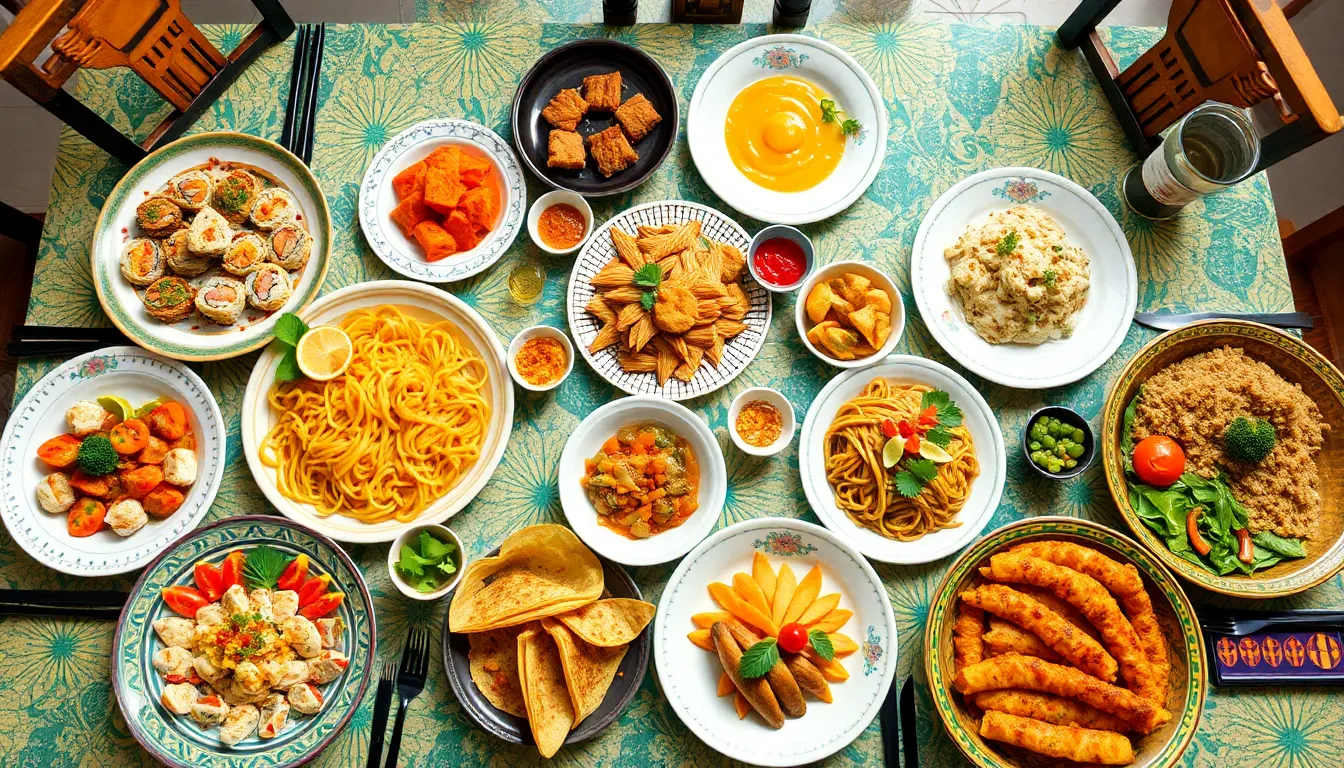Exploring international dining opens a world of flavors and cultures right at the table. From the spicy street food of Bangkok to the refined elegance of French cuisine, each dish tells a story that transcends borders. This culinary journey invites food lovers to experience the rich tapestry of traditions that shape global gastronomy.
In an increasingly interconnected world, international dining is more accessible than ever. Whether it’s a cozy neighborhood restaurant or an adventurous food festival, the diversity of global cuisine offers something for everyone. Discovering new ingredients and cooking techniques can inspire home cooks and seasoned chefs alike, making every meal an opportunity to travel without leaving the kitchen.
Table of Contents
ToggleWhat Is International Dining?
International dining encompasses the culinary practices and foods from around the globe. It includes traditional dishes, unique recipes, and innovative adaptations from different cultures. Dishes like Thai curries, Italian pastas, and Mexican tacos each reflect their region’s history and social customs.
International dining often emphasizes the use of indigenous ingredients. Fresh herbs, spices, and local produce enhance the authenticity of each cuisine. Seasonal availability also influences menus, encouraging chefs to celebrate local flavors while incorporating global influences.
Restaurants specializing in international dining often provide immersive experiences. They may feature cultural music, decor, and events that highlight the traditions associated with the food. This approach cultivates a deeper appreciation for the stories behind each dish.
Food festivals celebrating international cuisines allow people to sample a variety of dishes in one location. Such events foster multicultural understanding and encourage culinary exploration.
The trend of international dining has gained traction due to globalization. It’s easier than ever to access diverse cuisines in urban areas or through global delivery services. As home cooks seek to replicate restaurant-quality dishes, they discover new techniques and ingredients that broaden their culinary repertoire. International dining invites exploration and promotes community through shared food experiences.
Popular International Cuisines

International dining encompasses a variety of culinary traditions that reflect the unique histories and cultures of regions worldwide. Each cuisine offers distinctive flavors and dishes that showcase local ingredients and cooking techniques.
Asian Cuisine
Asian cuisine features an extensive array of flavors and techniques, with notable varieties including Chinese, Japanese, Indian, and Thai dishes.
- Chinese: Known for its balance of flavors and textures, dishes like dim sum and Peking duck highlight regional variations such as Sichuan’s spicy offerings and Cantonese’s emphasis on freshness.
- Japanese: Characterized by simplicity and seasonal ingredients, sushi and ramen exemplify the craftsmanship and artistry of Japanese cooking.
- Indian: Rich in spices and flavors, Indian cuisine showcases dishes like curry and biryani, with regional specialties ranging from North Indian tandoori to South Indian dosa.
- Thai: Renowned for its bold combinations of sweet, sour, salty, and spicy, Thai dishes like pad Thai and green curry reflect the harmony found in Thai cooking.
European Cuisine
European cuisine offers a diverse selection influenced by geography and tradition, with key examples from French, Italian, and Spanish cooking.
- French: Celebrated for its refined techniques, French cuisine includes classic dishes like coq au vin and bouillabaisse, showcasing the importance of technique and presentation.
- Italian: Known for its comfort foods, Italian cuisine features pizza, pasta, and risotto, with regional variations like Neapolitan and Tuscan adding depth to its offerings.
- Spanish: Famous for tapas and paella, Spanish cuisine integrates fresh seafood and vibrant spices, demonstrating a festive approach to dining.
Latin American Cuisine
Latin American cuisine is distinct for its fusion of indigenous and colonial influences, with popular dishes hailing from Mexico, Brazil, and Argentina.
- Mexican: Vibrant and flavorful, Mexican cuisine features tacos, enchiladas, and mole, utilizing ingredients such as corn, beans, and chili peppers.
- Brazilian: Known for its hearty flavors, Brazilian cuisine offers dishes like feijoada and pão de queijo, integrating African, Portuguese, and indigenous elements.
- Argentinian: Renowned for its beef, Argentinian cuisine prominently showcases asado and empanadas, highlighting the country’s barbecue culture and rich agricultural heritage.
African Cuisine
African cuisine varies widely, with each region presenting unique ingredients and flavors. Key culinary traditions include North African, Sub-Saharan, and East African cuisines.
- North African: Characterized by complex spices, North African dishes like tagine and couscous reflect the region’s Berber and Arab influences.
- Sub-Saharan: Emphasizing staples like yams, cassava, and plantains, Sub-Saharan cuisine includes dishes such as jollof rice and injera, showcasing vibrant flavors and communal dining.
- East African: Featuring fresh produce and seafood, East African cuisine presents dishes like ugali and samaki, often flavored with spices and herbs that illustrate the region’s diverse cultures.
Dining Etiquette Around The World
Understanding dining etiquette is essential for an enriching international dining experience. Customs vary widely, affecting how one interacts with food and fellow diners.
Tipping Customs
Tipping customs differ globally, reflecting cultural attitudes toward service. In the United States, tipping 15-20% of the bill is standard, while in Japan, tipping may be considered rude and unnecessary. In some European countries like France, service charges are typically included, although small tips for exceptional service are appreciated. In contrast, countries like Mexico encourage tipping, generally around 10% of the total bill. Recognizing these practices enhances mutual respect when dining internationally.
Table Manners
Table manners vary significantly across cultures and influence the dining experience. In many Asian cultures, such as China and Japan, slurping noodles indicates enjoyment, while in Western cultures, this behavior may be seen as impolite. In Italy, it’s customary to break bread by hand, whereas in the Middle East, using the right hand only for eating is essential due to cultural beliefs. Maintaining proper posture and avoiding talking with a full mouth are common expectations in dining settings worldwide. Adapting to these manners demonstrates awareness and respect for diverse cultural traditions.
The Rise Of Global Food Trends
The globalization of food has birthed an exciting phenomenon known as fusion cuisine, blending diverse culinary traditions. Additionally, the growing interest in plant-based dishes enhances the international dining landscape by spotlighting unique flavors and sustainable practices.
Fusion Cuisine
Fusion cuisine marries culinary elements from different cultures, creating innovative dishes that reflect our interconnected world. Chefs experiment with ingredients and techniques, resulting in dishes such as Korean tacos, which combine savory Korean barbecue with traditional Mexican flavors. Other examples include sushi burritos, merging Japanese sushi with the convenience of a burrito, and Italian-Indian pizza that features toppings like tandoori chicken and naan crust. These combinations celebrate diversity, providing diners with fresh, unexpected flavors while promoting cultural exchange. Restaurants specializing in fusion cuisine often emphasize creativity, making dining an adventurous experience.
Plant-Based International Dishes
Plant-based international dishes showcase the versatility of vegetables, legumes, and grains across global cuisines, aligning with the trend toward healthier eating habits. Indian cuisine offers numerous plant-based options, including chana masala and vegetable biryani, showcasing aromatic spices and fresh produce. Mediterranean fare features dishes like falafel and tabbouleh, rich in herbs and legumes, while Ethiopian cuisine boasts injera served with a variety of flavorful vegetable stews. Asian dishes also highlight plant-based ingredients, with options like Vietnamese pho using vegetable broth and tofu. These dishes not only cater to dietary preferences but also reflect sustainable eating practices by minimizing environmental impact and emphasizing local ingredients.
International dining offers a gateway to explore the world’s diverse culinary landscape. Each dish tells a story and reflects cultural heritage, inviting diners to appreciate the artistry behind every meal. As globalization continues to connect people, the opportunity to experience international flavors has never been more accessible.
Whether dining at a local restaurant or experimenting at home, the joy of discovering new cuisines enriches lives and fosters understanding among cultures. Embracing international dining not only enhances culinary skills but also promotes community and respect for traditions. It’s a delicious journey worth embarking on.





